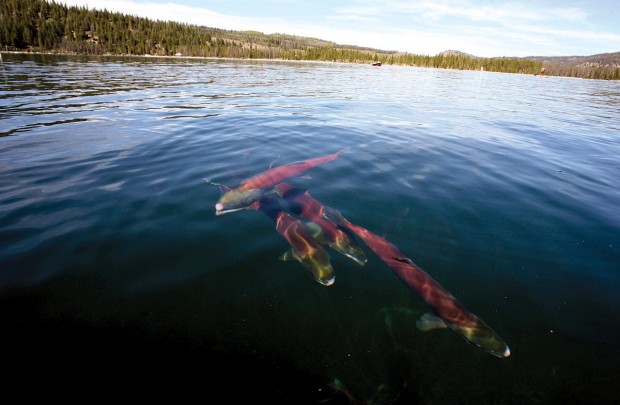forum
library
tutorial
contact

270 Sockeye Return to Central Idaho
by StaffColumbia Basin Bulletin, October 25, 2013
|
the film forum library tutorial contact |

|
270 Sockeye Return to Central Idahoby StaffColumbia Basin Bulletin, October 25, 2013 |
Some Spawners' Eggs Go To New 'Recolonization' Hatchery
 A relatively high crop of sockeye salmon spawners returning to central Idaho will soon be sharing the task of recovering a species that 20 years ago was all but extinct.
A relatively high crop of sockeye salmon spawners returning to central Idaho will soon be sharing the task of recovering a species that 20 years ago was all but extinct.
Roughly 270 adult sockeye spawners have made their way up the Columbia, Snake and Salmon rivers this year to spawn after swimming out to the Pacific Ocean as juveniles and maturing to adulthood.
A total of 128 of the "anadromous" Snake River sockeye, fish that began their life in central Idaho's Stanley Basin and grew up in the Pacific Ocean before returning to spawn, were released into Redfish Lake near Stanley, Idaho, and allowed to spawn naturally.
Some were trapped late this past summer and held at the Idaho Department of Fish and Game's Eagle Hatchery until spawning time, when they were transported to the lake for release. Others were allowed to proceed on their own to the lake.
The lake spawning group was joined by 87 adult fish that were born and raised to adulthood at Eagle Hatchery and 64 adult fish raised at NOAA Fisheries' Manchester Research Station in western Washington.
"More than 300 fish" were released into the lake to spawn, according to the IDFG's Dan Baker, Eagle Hatchery manager.
A total of 84 of the returning sockeye were kept for captive spawning. About 250,000 of their eggs will be sent to the Springfield hatchery in eastern Idaho in December to produce a first crop of juvenile sockeye at the facility.
Redfish Lake sockeye are unique to the Pacific Northwest. They migrate farther than any other, traveling more than 900 miles from the Pacific Ocean to Redfish Lake near Stanley, Idaho. At nearly 7,000 feet above sea level, the Stanley Basin is the highest elevation to which any sockeye salmon return. Redfish Lake sockeye are also the southern-most spawning population of sockeye salmon in the world.
A grand opening of sorts was held Friday, Sept. 6, to mark the completion of the new Springfield Hatchery
The $13.5 million facility will ultimately be capable of producing up to 1 million juvenile Snake River sockeye annually for release in the Sawtooth Basin of central Idaho, the headwaters of the Salmon River.
The additional capacity - up from a capability of about 200,000 smolts now produced annually with available space at two other hatcheries - is intended to boost efforts to recover Snake River sockeye, which are listed as endangered under the Endangered Species Act. The added production will shift the effort from a "conservation" phase aimed at assuring the Snake River sockeye don't go extinct to a "re-colonization" phase where emphasis will be on returning increasing numbers of ocean-run adults to use in hatchery spawning and to release to the natural habitat to spawn.
The increase in adult fish may eventually lead to recreational and tribal fishing seasons on Snake River sockeye, a species that was listed in 1991 after a period when annual returns dropped as low as zero in some years.
The hatchery is funded by the Bonneville Power Administration as part of its obligation to mitigate the impact of hydropower dams on salmon and steelhead. It will be operated by Idaho Fish and Game
The current run of sockeye into the Snake River is one of three remaining populations in the Columbia River basin. The other two populations are in Okanogan and Wenatchee lakes, on tributaries of the upper Columbia River. Efforts are under way to restart sockeye in Oregon's Deschutes River basin and Washington's Yakima River basin.
Partners in the Snake River sockeye recovery effort include Idaho, Oregon, Washington, NOAA-Fisheries, the Shoshone-Bannock Tribe, Bonneville Power Administration and the Northwest Power and Conservation Council.
The Redfish Lake Sockeye Captive Broodstock Program, a multi-agency and tribal effort started in May 1991, was initiated to protect population genetic structure and to prevent the further decline of Idaho sockeye salmon. The program also produces eggs and fish to reintroduce to the habitat to increase population numbers.
Between 1991 and 1998, only 16 wild sockeye salmon returned to Idaho. All of these adults were incorporated into the captive breeding program and spawned at the Eagle Fish Hatchery. The program releases eggs and fish back to the habitat in a variety of ways.
Related Pages:
Count the Fish by Government Accounting Office, GAO-02-612, Salmon and Steelhead Recovery Efforts
learn more on topics covered in the film
see the video
read the script
learn the songs
discussion forum
